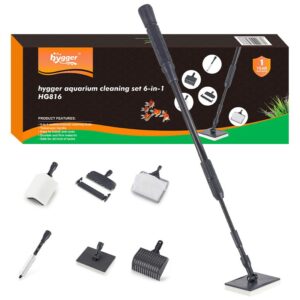In community tanks, the fish fight rate may be relatively high. Because if you keep incompatible fish in one tank, it would be a nightmare. So, how to keep balance in a tank? For example, zebrafish and angelfish community fish tank balance. Just read on to know more.
Content Table
When Zebrafish Opens the Hunt Mode
Zebrafish, also named Danio rerio or Zebra danio, is a tropical freshwater fish, belonging to the Cyprinidae family. Generally, they can grow up to 1.6-2 inches (4-5 cm) in captivity, and they can live up to about 3–5 years. Usually, it is recommended to keep them in a minimum tank size of 10 gallons. Furthermore, Zebrafish are social fish and active during the day. You can keep them in groups of three or more.
Besides that, Zebrafish are omnivorous. And the available foods include worms, brine shrimp, pellets, flakes, etc. Commonly, Zebrafish are peaceful, but they will open the hunt mode during the feeding process. And it would cause inadequate food for other tank mates.
Moreover, if you want to learn more about zebrafish, you can go to:
How to Keep the Balance for Zebrafish and Angelfish
Zebrafish and angelfish are peaceful. However, sometimes zebrafish will open hunt mode, leading to inadequate food for angelfish. So, how can you keep the balance for zebrafish and angelfish?

Before getting into this question, let’s take a look at the basic information and tank requirements for the two fish.
| Zebrafish | Angelfish | |
| Ideal water temperature | 78-80℉ | 78-84℉ |
| pH level | 6.5-8.0 | 6.8-7.8 |
| Temperament | Peaceful | Peaceful |
| Diet | Omnivore | Omnivore |
| Minimum tank size | 10 gallons | 30 gallons |
Needless to say, providing a comfortable living environment is the top priority. Additionally, there are some tips about keeping balance for zebrafish and angelfish. Just read on.
- Feed your fish properly, including proper food, feeding frequency, and feeding amount.
- Leave enough space. Crowded tanks may trigger health problems.
- Add aquarium plants. Plants provide hiding places, and they also help to improve oxygen levels.
Keeping the Community Fish Tank Balanced
In this segment, we will share some suggestions for keeping the community fish tank balanced.
- Never keep incompatible fish in one tank.
- Never introduce fish that would consume plants to planted aquariums.
- You can add compatible bottom, middle, and top fish in one tank.
- Tank mates should have similar requirements for the living environment.
- Keep sick fish in quarantine tanks to decrease the infection rate.
- Do regular water changes and tank cleaning.
- Check the aquarium equipment regularly to determine whether they are running or not.
Aside from that, there are some compatible community fish. If you want to set up a community tank, you can choose one mentioned in the table below.
- Powder Blue Gourami & Peacock Gudgeon
Powder Blue Gourami and Peacock Gudgeon are peaceful tropical fish. They do well in a water temperature of 78-80℉ (25-26℃). Also, the minimum tank size should be 20 gallons. Commonly, they can get along well with each other. But occasionally male ones may be aggressive.
- Red Wag Platy & Velvet Wag Swordtail
Featuring peaceful temperament, Red Wag Platy and Velvet Wag Swordtail can do well in a minimum tank of 10 gallons with gravel and a few aquarium decors. Usually, they prefer a water temp of 78-80℉ (25-26℃).

How to Know If the Aquarium Is Out of Balance
Fish appearance and behavior
Besides that, if the aquarium is out of balance, fish would show some abnormal behavior and signs. Given below are some pointers.
- Inactive fish. The fish just stay at the bottom of your tank.
- Red gills. It may show a high ammonia level.
- Gasp for air on the water’s surface. It indicates high levels of nitrite and nitrate, which may cause fish poisoning and make them hard to breathe.
- Rotten fins. It may be the result of increasing pH levels.
- Loss of diet.
Observe tank status
Additionally, your aquarium will also give you some hints. For example, once you find dead fish, it is time to check everything in your tank, like aquarium water and filter. Moreover, cloudy water can be a signal of requirements for water changes and aquarium cleaning.
What to do when facing something abnormal in your tank
You can check the aquarium water to determine whether your aquarium is out of balance or not. For instance, pH level, nitrite level, nitrate level, etc. You can do this with the help of aquarium water test strips and an aquarium hydrometer. Usually, the water test strips are easy and convenient to use. Like the 8-in-1 water test kit testing for 8 aquarium water parameters, including pH level, hardness, ammonia nitrogen, nitrate, nitrite, total chlorine, carbonate root, and total alkalinity. Plus, an aquarium hydrometer will make sense in testing salinity and specific gravity in marine reef aquariums.
By the way, as for how to deal with the imbalance in aquariums or how to keep fish tanks balanced, just stay tuned. We will cover more in the later blogs.
To Be Continued
To conclude, no matter what fish you keep, ensuring a great living environment is critically crucial. Otherwise, your fish and tanks will have some kind of issues. Plus, it is better to research whether the fish are compatible or not before adding them to one tank.
More about how to keep a balanced tank, just stay tuned to hygger blog. Finally, thanks for taking the time, and we hope this article helps.




Leave a comment